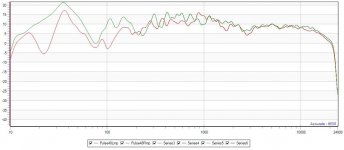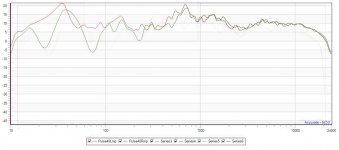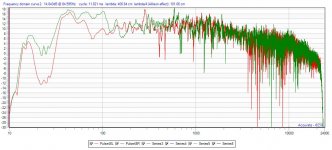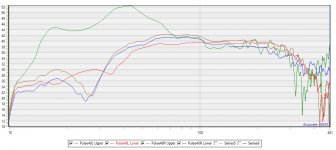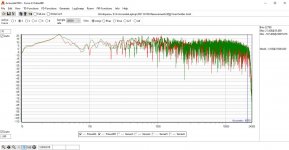Hi:
In my process of conducting digital room correction for my audio room for my B&W 802D speakers. I noticed that one speaker has an approx 6dB lower in peak at around 40Hz, and the roll off is very different. I swapped the speakers in position, and the similar characteristics followed with the weaker speaker to the other position. These speakers are about 15 years old. I checked the crossover on both speakers, and visually nothing seems to be wrong i.e. capacitor physical shape not distorted. I have attached the amplitude responses with weaker speaker in right, and left position. Also, a picture of the crossover.
Any ideas on why the weaker speaker at low frequency is behaving like this?
Regards,
RF Phil
In my process of conducting digital room correction for my audio room for my B&W 802D speakers. I noticed that one speaker has an approx 6dB lower in peak at around 40Hz, and the roll off is very different. I swapped the speakers in position, and the similar characteristics followed with the weaker speaker to the other position. These speakers are about 15 years old. I checked the crossover on both speakers, and visually nothing seems to be wrong i.e. capacitor physical shape not distorted. I have attached the amplitude responses with weaker speaker in right, and left position. Also, a picture of the crossover.
Any ideas on why the weaker speaker at low frequency is behaving like this?
Regards,
RF Phil
Attachments
Can you do an impedance sweep on both speakers? That would tell you if the xover is bad. What is DCR on both cabs?
It could be a defective driver and the only way to tell is removing it and checking DCR with an ohm meter. If that doesn't tell you, an impedance sweep on the woofer will. If I'm not mistaken, your speaker uses a dual voice coil woofer, so one of the VCs may be disconnected or bad. The DCR would be double that of the good speaker, so maybe check that first.
It could be a defective driver and the only way to tell is removing it and checking DCR with an ohm meter. If that doesn't tell you, an impedance sweep on the woofer will. If I'm not mistaken, your speaker uses a dual voice coil woofer, so one of the VCs may be disconnected or bad. The DCR would be double that of the good speaker, so maybe check that first.
B&W802D Speaker A vs. B: Near Field Measurements
Hi: I have measured each speakers in near field, see attached plot for full frequency response. The 802D has two bass drivers. I have measured each driver with mic about 3 inch away from driver centre: Left Upper, Left Lower, Right Upper, and Right Lower. Bass response plot is also attached.
Looking at the full frequency response plot, the Left speaker low frequency response is weaker than the right one. However, one of the Left speaker bass driver (Left Upper) has a much higher amplitude response than the other three bass drivers.
I will get my hands on a DATS V3 soon to conduct impedance sweep. However, the above is puzzling.
Any thoughts?
Regards,
Phillip
Hi: I have measured each speakers in near field, see attached plot for full frequency response. The 802D has two bass drivers. I have measured each driver with mic about 3 inch away from driver centre: Left Upper, Left Lower, Right Upper, and Right Lower. Bass response plot is also attached.
Looking at the full frequency response plot, the Left speaker low frequency response is weaker than the right one. However, one of the Left speaker bass driver (Left Upper) has a much higher amplitude response than the other three bass drivers.
I will get my hands on a DATS V3 soon to conduct impedance sweep. However, the above is puzzling.
Any thoughts?
Regards,
Phillip
Philip,
The impedance sweep is likely to indicate if there are any mismatches in the drivers, XO, or cabinet.
If you swap the woofers between the boxes and you still get the same measurements, then it is likely that the drivers are ok.
The impedance sweep is likely to indicate if there are any mismatches in the drivers, XO, or cabinet.
If you swap the woofers between the boxes and you still get the same measurements, then it is likely that the drivers are ok.
Have the crossovers been modified? I believe Mundorf existed in 2006, but the caps seem somewhat new to me.
The levels look near identical from 40Hz and down to me - when you flip between the two measurements the red becomes green and the green becomes red with little other change at those low frequencies. This indicates to me that all the woofers are probably operational in both cabinets.
The biggest difference I'm seeing between cabs in your measurements are around 60-200Hz. This is where i'd expect the woofer impedance to dip the lowest, so I'd suspect that perhaps the DC resistance of the woofer inductors are somehow different between each speaker. Do the crossover components look identical in both cabinets? If someone has modified them in the past also check that they haven't reconnected some of the wiring back into the wrong positions or reversed the polarity of any connections.
It's also possible that there is a dry solder joint on the circuit board and a component has gone open circuit - I'd suspect a capacitor in the woofer section specifically. Try touching up the joints on all the components in the woofer sections. I'd suspect it unlikely for a poly capacitor to fail but you never know! Test them if you have the ability to.
Finally check that the woofers haven't suffered rubbing voicecoils. Gently push the cones in and check for crunchy feel or noises.
The biggest difference I'm seeing between cabs in your measurements are around 60-200Hz. This is where i'd expect the woofer impedance to dip the lowest, so I'd suspect that perhaps the DC resistance of the woofer inductors are somehow different between each speaker. Do the crossover components look identical in both cabinets? If someone has modified them in the past also check that they haven't reconnected some of the wiring back into the wrong positions or reversed the polarity of any connections.
It's also possible that there is a dry solder joint on the circuit board and a component has gone open circuit - I'd suspect a capacitor in the woofer section specifically. Try touching up the joints on all the components in the woofer sections. I'd suspect it unlikely for a poly capacitor to fail but you never know! Test them if you have the ability to.
Finally check that the woofers haven't suffered rubbing voicecoils. Gently push the cones in and check for crunchy feel or noises.
Last edited:
These look like far-field responses. If near-field responses (ie microphone 1cm away from the cone) have been posted I can't see them.
Just looks like room modes to me.
Just looks like room modes to me.
Crossover in both speakers do look like untouched from factory. Will swap the bass drivers between the two boxes to get more insight.
Thanks
Thanks
The 802D is a ported design. A close range measurement of the woofer should give a level suckout on the port resonance. I think the woofers share the ported volume, what I see is both woofers not giving the expected response like in the other enclosure.
Most likely one of your woofers is electrically disconnected or defunct and acts as a maltuned passive radiator in conjunction with the port. The other doesn't get much acoustic resistance of the cabinet and plays -quite- undamped. As shows the level at about resonant frequencies.
Most likely one of your woofers is electrically disconnected or defunct and acts as a maltuned passive radiator in conjunction with the port. The other doesn't get much acoustic resistance of the cabinet and plays -quite- undamped. As shows the level at about resonant frequencies.
B&W802D Speaker A vs. B: Problem Solved
Thanks to the ones who replied to my question.
Markbakk, your assessment is right on including the electrically disconnected bass driver acting like a passive radiator and being out of control compared to the other bass drivers. Thank!
I swapped the bass drivers between left and right speakers, and the problem followed e.g. not a crossover problem. I tested one bass driver in the box at a time, and then found one of the bass driver was not responding i.e. dead.
Ohm meter showed it was open circuit between the two connections on the basket. Re-solder the connections, and now it works. See attached room measurement plot.
Again, thanks for everyone's reply.
Thanks to the ones who replied to my question.
Markbakk, your assessment is right on including the electrically disconnected bass driver acting like a passive radiator and being out of control compared to the other bass drivers. Thank!
I swapped the bass drivers between left and right speakers, and the problem followed e.g. not a crossover problem. I tested one bass driver in the box at a time, and then found one of the bass driver was not responding i.e. dead.
Ohm meter showed it was open circuit between the two connections on the basket. Re-solder the connections, and now it works. See attached room measurement plot.
Again, thanks for everyone's reply.
Attachments
- Home
- Loudspeakers
- Multi-Way
- B&W802D Speaker A vs. B: Low Frequency Response Differences
